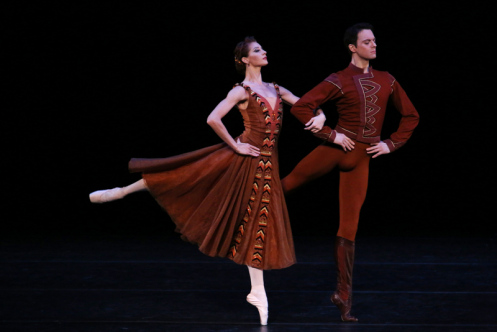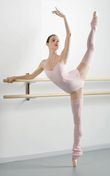At one point during a principal woman’s solo, I became aware that the corps women, arranged in three florets framing the stage, were slowly, almost imperceptibly, blossoming open as they moved from a standing position to a kneeling one—with one woman in each bunch remaining upright in the middle like a stamen. I wanted to applaud like crazy for them, but not exactly for the
I wondered how much rehearsal they had had with the pianists too, for it is very difficult to dance to solo piano if one is underprepared. Normally, dancers can look at the conductor in the orchestra pit and have some idea of how long a ritardando or a fermata will last. With solo piano, dancers are flying blind—although the pianist can usually see the dancers the dancers cannot see the pianist. Anytime we dance to a cadenza or any un-conducted instrument (like in Allegro Brillante, Opus 19/The Dreamer, or any of the Robbins solo piano works like Goldberg) we rehearse extensively with the musicians in the studio to establish a baseline tempo. Of course there is always some slight variation from both musician and dancer during the passion of performance!
The Chopiniana leads also had to contend with the quietude of the piano in combination with hollow-sounding floors of the BAM Opera House. This was not as much of an issue in the later ballets, which had fewer dead-weight jumps, but it was terribly distracting in the Fokine piece with all of its straight leg grand jetés. The first time the male lead Timur Askerov landed a huge tour jeté jump with an inescapable thud the whole audience recoiled. Eventually we got used to the extra percussion from the stage, but it was unfortunate. I felt like it made the dancers uncomfortable and self-conscious about their landings, but the tempos were so slow that they had no choice but to jump that way. I also thought that the solo piano sounded a little silly playing the extra-long, bombastic overture. Maybe this piece simply needed an orchestra. Or maybe this music is inherently comical: Jerome Robbins uses it to much greater affect in his balletic spoof The Concert.
But the Chopiniana dancers nobly went about their business and delivered a very pretty rendering of the piece. The lead couple, Oxana Skorik and Timur Askerov, floated seamlessly through their pas de deux work. With the Romantic forest backdrop and the perfect long white tutus—complete with little fairy wings that never sagged—it was beautiful ballet beautifully executed. The corps moved like clockwork, the leads all soared high into the air with supply arched feet. My one complaint would be that it lacked some spunk. The direct approach was utterly classical and pure, but maybe a little stuffy. I admired it tremendously but it didn’t stir my soul or make me excited about dancing. I was so glad to see it though, we are doing Bournonville’s full-length La Sylphide in May and it is good to have a reference point of the ideal delivery of that style and movement.
Benjamin Millepied’s Without (2011) followed, which is a ballet I really like. I had seen it performed once before by ABT dancers at the Joyce. It was nice to see this ballet juxtaposed with Robbins’s In the Night, because it borrows some of the latter piece’s aesthetic, especially the way that the dancers quickly run offstage and back on, often popping out of different wings. It is also reminiscent of Robbins’s Dances at a Gathering, maybe with a little of Balanchine’s Brahms-Schoenberg Quartet thrown in. The set consists of draped fabric around the circumference of the stage with multiple slits through which the dancers slip in and out—the same as in Robbins’s The Cage, come to think of it. Clearly, Ben borrows a lot from the greats, but he always does it in a classy, clever way. I even noticed a very specific lift from Who Cares? in there that looked fresh in the updated context. The dancers in Without were much freer than those in Chopiniana. But still they had too much rigidity through their thoracic spines which made them seem slightly uptight. Ben’s movement is quite modern and often requires rolling through the neck and back. Kristina Shapran, in the blue dress, was the best at this and she was my favorite.
Jerome Robbins’s In the Night (1970) closed the program. I always love this ballet, and this afternoon was no different. The piece consists of three pas de deux and a brief finale where all the couples bump into each other as if by accident under a starry sky. The first pas represents young passion, the middle pas is about a mature relationship built on trust and respect, the last pas is about tempestuous lovers who break up and reconcile repeatedly. The dancers who performed the second pas de deux, Yekaterina Kondaurova and Yevgeny Ivanchenko, gave quite possibly the finest account of the work that I’ve ever seen. The gorgeous Ms. Kondaurova had copper hair to match her copper dress, and she was so elegantly regal she could have been a tsarina. She alone hung confidently on the music so that she was never rushing, always perfectly arriving with the notes of the piano. I think the Mariisnky style lent itself perfectly to this particular pas too. The other two couples had some partnering issues, and their drama felt more campy than organic at times. But all in all it was a great day at the ballet. And I have been trying to channel Ms. Kondaurova for my baroque and reserved Goldberg pas, so I am grateful for that inspiration.


 RSS Feed
RSS Feed